Dieffenbachia plant pronounced (deef-en-BOK-ee-uh), also known as the “Dumb Cane,” makes an excellent tropical houseplant.
“Dieffs” tolerance of shade makes them a good plant to begin learning the basics of indoor houseplant care.
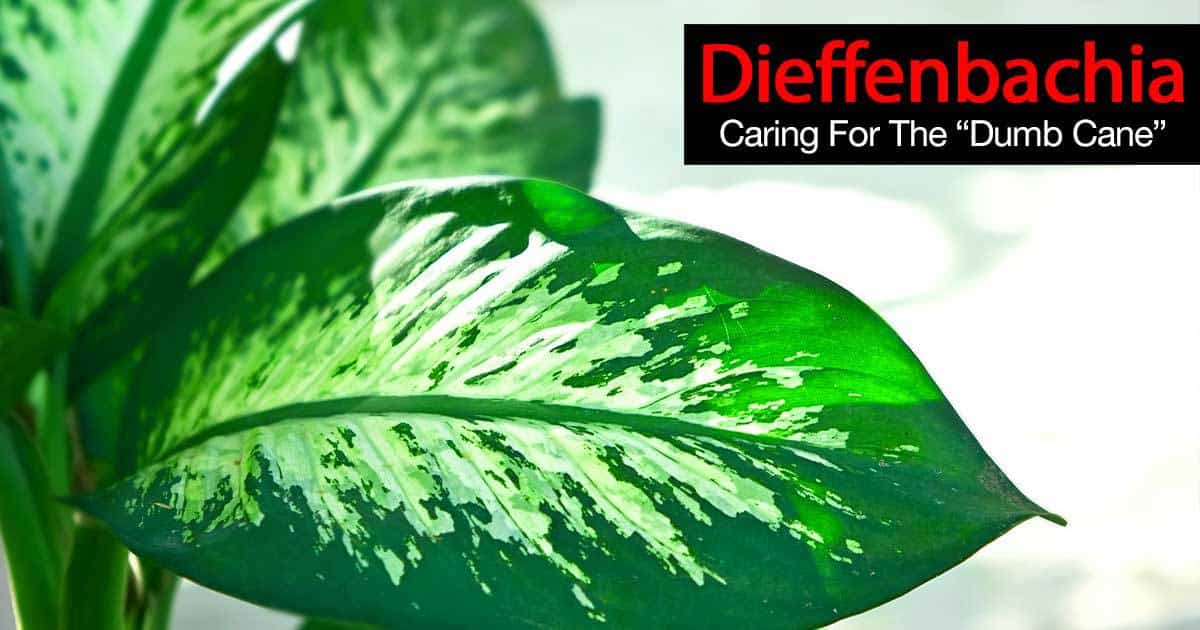
In this article, we share care tips on common indoor Dieffenbachia care along with answers to some of the most common questions on “dumb cane” regarding:
- How poisonous are Dieffenbachia plants to cats, dogs, and children?
- How to on propagation
- What to do when plants get too tall
- Leaves turning yellow
- and much more
Let’s get started!
- Quick Dieffenbachia Care Guide
- Why Is The Dieffenbachia Called “Dumb Cane”?
- Where Did The Name “Dieffenbachia” Come From?
- Does The Dieffenbachia Flower?
- What Is Dieffenbachia Amoena?
- How Do You Care For A Dieffenbachia Plant?
- How To Propagate Dieffenbachia Plants
- Dieffenbachia Pests and Diseases
- What Are The Most Popular Dieffenbachia Varieties?
- What Are The Best Uses For The Dieffenbachia Plant?
- Wrapping Up Caring For Dieffenbachia
Quick Dieffenbachia Care Guide
- Botanical Name: Dieffenbachia – (deef-en-BOK-ee-uh)
- Common Name(s): dumb cane,
- Family & Origin: Araceae – New World Tropics, South America, Mexico, West Indies south to Argentina
- Growability: Easy to grow
- Grow Zone: USDA hardiness zones 10-12
- Size: Small varieties 12″-24″ inches | Tall varieties up to 6″ feet tall
- Light: Medium to high indirect sunlight (bright east or south window)
- Temperature: 70°-80° degrees Fahrenheit – damage occurs below 50° degrees Fahrenheit, likes humidity
- Soil: Plant Dieffenbachia in houseplant soil or DIY two parts peat moss and 1 part perlite.
- Water: Keep the potting medium moist, it can tolerate some soil drying.
- Fertilizer: Apply a liquid houseplant fertilizer at 1/2 strength every 6 weeks to 2 months.
- Pests & Diseases: mealybugs, spider mites
- Propagation: Tip cutting or stem segments
- Toxicity: Dieffenbachias are poisonous and toxic, it causes swelling of the throat, skin irritation, and more.
- Grooming: Wipe leaves monthly with a damp cloth to remove dust.
- Uses: Display on a tabletop, large varieties use as a floor plant
Why Is The Dieffenbachia Called “Dumb Cane”?
Through the years, the plant Dieffenbachia has also been known as the mother-in-law tongue (the common name used for Sansevieria, aka “snake plant”), referring to the toxic sap with calcium oxalate crystals, which inflame the tongue and throat, causing temporary loss of speech if ingested.
It’s been reported that slaves were given “dumb canes” as a form of punishment (more below). [source]
Where Did The Name “Dieffenbachia” Come From?
The name Dieffenbachia was given to the genus by Heinrich Wilhelm Schott, the director of the Botanical Gardens in Vienna, to honor the head gardener Joseph Dieffenbach (1796–1863).
Schott was a botanist well known for his extensive work on the aroids (Family: Araceae). [source]
The herbaceous perennial Dieffenbachia originates from the New World tropics rainforests of Mexico to Argentina and the West Indies.
The plant has alternate, simple leaves with white flecks or spots attached to straight stems. The native origin provides some idea of the type of care and conditions the plant likes.
Is The Dieffenbachia Poisonous?
This is a question many ask. Yes, the dumbcane is poisonous and toxic to humans and pets, causing swelling of the throat and skin irritation, and more.
So it’s important to properly handle this plant to avoid being poisoned. You can wear gloves and wash your hands after handling it.
For details, read our article – Is The Dieffenbachia Plant Poisonous?
Does The Dieffenbachia Flower?
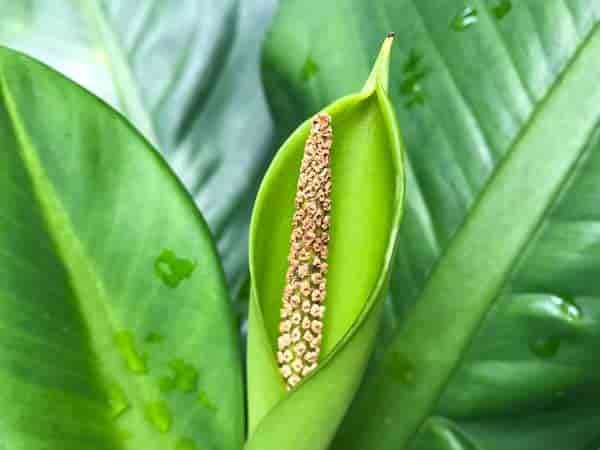
The Dieffenbachia plants bloom but have no real smell or fragrance. The flowers (inflorescence) look like flowers on a calla lily or Monstera deliciosa.
After flowering, the center of the Dumb Canes stem “dies,” but side shoots usually form, and the plant continues to grow. As the side shoots mature, they can be removed, propagated, and planted to produce new plants.
What Is Dieffenbachia Amoena?
Dieffenbachia Amoena is the plant most people commonly know of all Dieffenbachia varieties.
It is one of the taller Dieffenbachia varieties growing to heights of around 4′ or 5′ feet as large single-stem specimens.
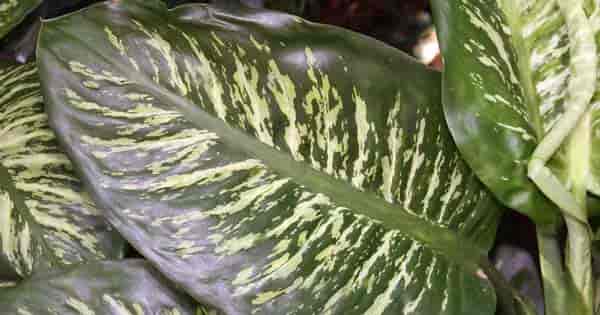
The thick stems support long, dark green-mottled foliage, and pointed, oblong leaves which ascend spirally around the canes.
A sport known as Dieffenbachia ‘Tropic Snow’ has been grown and sold as a common indoor house plant for decades.
The World Checklist Of Selected Plant Families at Kew Gardens currently lists 56 “accepted names” dating all the way back to Dieffenbachia seguine in 1832.
There have been additions and Dieffenbachia discoveries in the last 30 years by Croats at the Missouri Botanical Gardens and others.
Interestingly, as popular as Dieffenbachia Amoena is, the plant IS NOT an “accepted” species.
How Do You Care For A Dieffenbachia Plant?
Dieffenbachia is a hardy plant and will reward you with a long lifespan if properly cared for.
In terms of difficulty and requirements, it is one of the easiest indoor houseplants you’ll ever have the pleasure of caring for and maintaining. It grows no matter the month or season.
How Big Does Dieffenbachia Get?
The answer to plant size depends on the variety.
Dieffenbachia has given us a long list of handsome, available foliage plants with dozens of named species, variants, and hybrids. The list grows as more varieties appear each year.
The larger varieties like Dieffenbachia amoena grow 4′ – 5′ feet tall and can easily be 48” inches in width. This requires the plant to be planted in larger pots (14” inches or more) to not become too top-heavy.
The large varieties make perfect additions due to their exotic appeal for indoor spaces with lots of room.
The smaller, almost dwarf Dieffenbachia varieties like ‘Compacta,’ as the name implies, grow to only 24” – 28” when mature.
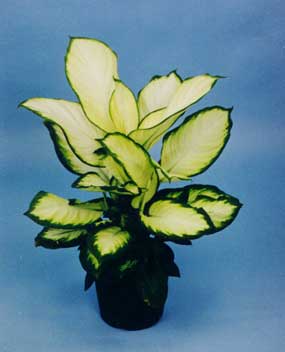
The one difference is the smaller Dieffenbachia varieties have a tendency to sucker heavily, producing a very bushy plant. They also have a much more natural mottling of white or yellow colors present in the leaves.
The smaller varieties are often times sports or variants. For example, Dieffenbachia Camille comes off a ‘Compacta’ variant, with cream-colored or white leaves that exhibit thin, green strips on its borders.
Some of the smaller varieties to look for at the garden center include:
- Dieffenbachia Camille
- Dieffenbachia Compacta
- Dieffenbachia Delilah
- Dieffenbachia Exotica
- Dieffenbachia Sparkles
- Dieffenbachia Star Bright
- Dieffenbachia Tiki
Dieffenbachia care is the same for both large and small varieties.
How Much Light Does The Dieffenbachia Need?
Dieffenbachia does well in a semi-sunny to partial shade location. As for lighting conditions, it thrives in bright indirect light, away from direct sunlight.
The tropical plant will, however, thrive in bright light conditions in warm climates. Dumbcanes do well when grown under artificial plant lights.
Bright light does make the ordinarily dark, lush growth and color the Dieffenbachia is known for to become dull.
Dieffenbachia can grow outdoors like a shade garden with lighting conditions that include lots of sunlight, but it needs protection from wind and the hot noon sun of summer, or plants begin to look sickly.
Too much sun will burn the leaves, but too much shade on the heavy white/yellow varieties will cause them to be poorly colored.
What Is The Best Temperature For Dieffenbachia Plants?
Dieffenbachia does well as a houseplant, thriving with year-round moderate indoor temperatures of 65° – 75° degrees Fahrenheit. Dieffenbachias will not tolerate low temperatures.
Anything below 60° degrees Fahrenheit and growth begins to slow. Some varieties start to show cold damage when temperatures fall below 55° degrees Fahrenheit.
In fact, high temperatures and bright light can make Dieffenbachia weak and sickly.
How Often Do You Water Dieffenbachia Plants?
Being from the aroid family Araceae – with cousins like the “Chinese Evergreen” (Aglaonema), “Peace Lily (Spathiphyllum),” and Philodendron – let us know dieffenbachia likes humidity.
As for watering, we recommend watering your indoor plants thoroughly and allowing the potting mix to thoroughly “approach dryness” between waterings.
Watering Dieffenbachia indoors is somewhat of an art form. There is no exact schedule. You need to consider the location, time of year, soil type, lighting, and humidity which all contribute to – How often you should water any houseplant.
Plants often need more water during the summer seasons and less during winter time. The growth cycle of this plant starts in March and ends in October.
Too much water (overwatering) may drown the fleshy roots, or cause rank, weak growth, and stems to become mushy. Make sure the planter or pot has drainage holes.
How Do You Fertilize Dieffenbachia?
The easiest way to fertilize a Dieffenbachias is to add a bit of liquid-plant food every other time you water the plants. Apply NO plant food during the winter months, only water.
Use a balanced, water-soluble liquid houseplant fertilizer at ½ strength when watering. For the most common liquid fertilizer for houseplants like Miracle-Gro, expect to mix a ½ tablespoon per gallon of water.
When repotting or transplanting, add a small amount of a solid time-release fertilizer to the soil. Always follow the recommended fertilizer rates you find on the fertilizer packaging.
What Is The Best Soil For Growing Dieffenbachia Plants?
A potting mix used in African violets care would be fine.
You’ll often find recommendations such as:
- One-part all-purpose loam
- One part peat moss
- One part of sharp sand, perlite, or vermiculite.
Growing Dieffenbachia outdoors on an open shaded patio, the above potting mix may work well.
When growing indoors as a houseplant, purchase a houseplant potting soil or make your own with two parts peat moss and 1 part perlite. Keep it simple.
Potting Tips: When potting or repotting plants, springtime is best just before the growing season begins. Do not overpot, and make sure the pot has drainage holes! This is because soggy soil will result in rot.
Dieffenbachia Pruning and Grooming
There is no need to ask “When to prune your Dieffenbachia” as it does not need grooming or pruning!
Older leaves will be yellow and need removing, but other than that, little “grooming” is required.
How To Propagate Dieffenbachia Plants
Propagating plants gives the homeowner a simple way to increase their collection. If your plant has grown too tall, why not try propagating your Dieffenbachia?
Related: Learn more in our article on Dieffenbachia Propagation.
Dieffenbachia Pests and Diseases
One of the most common questions asked in caring for Dieffenbachia is:
Why Are My Dieffenbachia Leaves Turning Yellow?
Yellowing leaves and brown tips come with several possibilities.
If your plant is healthy, and one or two dieffenbachia yellow leaves or brown tips on the leaves show up throughout the course of the year, it is most likely an old leaf.
The older lower leaves on dumb canes naturally die once they reach about one year old. If the plant is experiencing more than the occasional leaf dying off, a more serious problem may be starting to show.
Massive yellowing and dropping of leaves, including:
- Curled leaves
- Brown tips on the leaves
- Leaf tips are dying back.
- Plant rotting, wilting, and bleached foliage
- Weak new growth
Overwatering usually causes these conditions. Follow these steps to try and help the plant recover.
- Remove the plant from the pot
- Make sure the drainage holes are not clogged
- Check the roots for health.
- Roots should be white and free from any disease or rot.
- Remove any damaged roots
- Plant Dieffenbachia in the right soil
- If the root system looks good, and only a few roots need removing, put the plant back into the pot, add new soil if required, or repot using fresh soil.
- Remove all bad or damaged leaves.
- Place the plant in a well-ventilated area.
If, after removing the plant from the pot, the roots are mushy and soft, the plant will likely not survive. Take any tip and stem cuttings possible and follow the propagation tips above.
Throw the old plant out, including the soil.
Dieffenbachia Bacteria
Dieffenbachia is a tough plant whose one weakness is bacteria (Erwinia). The plant will exhibit rotting leaf joints that will spread throughout once it’s infected. Rotting can also start on the stem.
Once infected, there’s very little you can do to save the plant. Pots can be reused, but take the proper steps to disinfect them before reuse.
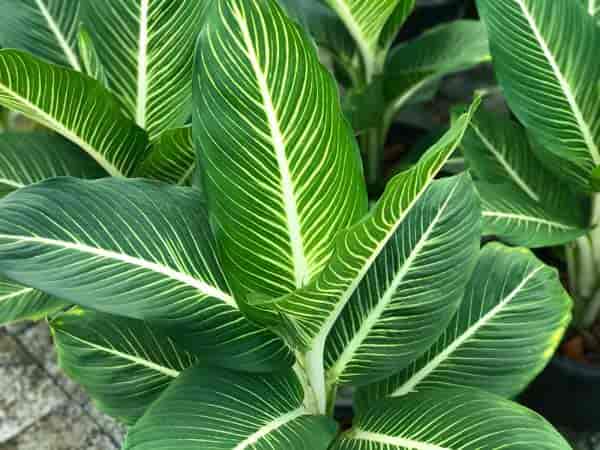
What Causes A Dieffenbachia To Have Brown Spots On Leaves?
Dieffenbachia does like humidity and does not like cool temperatures. When plants experience a sudden chill and too much humidity, a fungal disease known as anthracnose can develop.
The leaves will have black or dark tan spots in the center and dark, narrow margins. Leaf tips or margins become brown and die back.
- Remove and destroy these fungal-infested leaves.
- Keep plants on the dry side.
- Keep plants in a well-ventilated area.
- Spray healthy plants with a fungicide (neem oil) to stop the spread of the disease.
NOTE: Most homeowners will never experience the anthracnose problem with their plants indoors.
Brown Spots On White-Patterned Dieffenbachia Varieties
During the winter months, plants are not in an active growth phase, and the need for water and fertilizer is lower.
Leaves on white-patterned Dieffenbachia varieties – Compacta, Camille, Exotica, etc. – can exhibit dry brown spots during the winter caused by the potting mix staying too dry or too much fertilizer.
During winter months – DO NOT allow the potting mix to dry out completely and DO NOT fertilize!
Why Are The Stems and Roots Rotting On My Dieffenbachia?
When plant stems, and roots turn soft and mushy at the base, it’s known as – stem rot and root rot.
This is a fungus disease (Fusarium) caused by several conditions:
- Too much humidity
- Overwatering
- Temperatures too high
- Temperatures too low
Take the following steps to rescue the plant:
- Remove the plant from the pot
- Remove all soil
- Remove all infected areas – leaves, roots, and stems
- Treat all wounds with a fungicide
- Repot in fresh soil and a new pot (recommended)
- Allow the soil mix to dry well before rewatering
- Keep the plant in the proper growing conditions.
Top Down Stem Rot
Stems can also rot from the top down. What are the signs?
- Curled leaves
- Discolored foliage
- Soft foliage
- Leaves with brown edges
These “plant alerts” are caused by cold drafts and cold temperatures.
To combat top-down stem rot, take the following steps:
- Remove all infected areas
- Treat all wounds with a fungicide
- Move the plant to a warmer location.
NOTE: These spots aren’t caused by bacteria and will appear withered as compared to a rotten and smelly when they are infected.
Why does My Dieffenbachia have Distorted Leaves? (Dasheen Mosaic Virus)
Distorted leaves are often caused by the Dasheen mosaic virus. The virus is more common on select Dieffenbachia cultivars.
Symptoms include distorted leaves and stunted plants. Aphids and man commonly help spread the Dasheen mosaic virus. Today most pathogen-free Dieffenbachia stock is produced by tissue-cultured micro-cuttings.
No chemicals can control this virus disease. Monitor other plants such as Aglaonema, Spathiphyllum, and Philodendron for symptoms, as they can act as a host and reservoir for the virus. [source]
How To Control Mealy Bugs, Spider Mites, And Aphids On Dieffenbachia
The indoor conditions – warm and dry – during winter months make a perfect place for pests to set up shop on the underside of leaves and feed – sucking the juices out of your plants.
Any time of the year, those cottony, sticky-looking pests, mealybugs hide in clusters in leaf axils and on stems, even venturing to the root area. They also enjoy feeding on your Dieffenbachia.
Aphids enjoy sucking the juices and feeding on new growth during the active growing season.
To control these Dieffenbachia pests:
- Examine your plants weekly – all the way down to where the leaf meets the stem
- Clean and wipe the tops and bottoms of leaves
- Use sprays designed to control the insect pests, such as Malathion or organic Neem oil for plants – mealybugs, spider mites, aphids (homemade control), and other pests.
Neem Oil is our FAVORITE natural organic insecticide. Control aphids, mealybugs, plant scale, Japanese Beetles and more. It can also be used as a soil drench.
What Are The Most Popular Dieffenbachia Varieties?
Dieffenbachia – has been grown and available as a houseplant for decades. Over that time, many varieties have come and gone.
The varieties available break down into two groups based on their size – large plants and smaller “tabletop” selections.
Large Dieffenbachias – Floor Plants
These large varieties make striking individual specimens indoors if you have the real estate or outdoors on a covered patio for example.
The plants can reach heights of 4′ – 5′ feet if allowed. However, indoors a plant 30” – 42” inches tall is more the norm.
The most popular large varieties are:
Dieffenbachia Amoena, as discussed above. There are also various sports of “Amoena” available. The most popular or well-known patented variety is “Tropic Snow” PP 2,869.
The “Snow” was discovered in the 1960s as a sport in a block of Dieffenbachia amoena growing at Chaplin’s Nursery in Fort Lauderdale, Florida, according to US Patent Office records. I actually visited the nursery many years ago.
A patent for the plant Dieffenbachia amoena cv. Tropic Snow Plant Patent 2,869 was issued on February 25, 1969. It was the first Dieffenbachia to receive a patent.

The “discovery” document filed at The United States Patent Office on August 14, 1967:
“The present invention relates to a new and distinct variety of Dieffenbachia which was discovered by me in a shade house on my nursery property located at Davie, Fla., as a sport of the unpatented Dieffenbachia amoena.
My attention was attracted to one particular plant in this block which bore some variegated leaves quite different in appearance from the other leaves on this plant and different from those of all other plants in this block, as well as strikingly different from the leaves of all other Dieffenbachia varieties previously known to me.
Upon close inspection of this particular plant, I found that it had sported from a stem near the ground, and I accordingly took immediate steps to preserve the sport and keep it under close observation. Shortly thereafter, I took tip and cane cuttings from the sport to propagate the same, as performed by me in my nursery aforementioned.
Continued observations and tests of the sport and the progeny thereof derived from the cuttings aforesaid, have convinced me that it represents a new and improved variety which is distinctly different from the parent variety, as well as from all other Dieffenbachia varieties of which I am aware, as evidenced from the following unique combination of characteristics…” [source]
Small Dieffenbachias – Tabletop Plants
There are many smaller varieties available on the market, and many are produced from tissue culture micro cuttings. Most of these small varieties sucker heavily and produce lots of new growth.
Below are several well-known varieties growing in size from 18” – 30” inches.
Well-grown plants have stout stems, completely hidden by the bases of the leaf petioles where they clasp, but exposed below, where older lower leaves have fallen.
Dieffenbachia ‘Alix’ is a sport of ‘Tropic Snow’ with white and green variegated leaves but smaller and suckers well. [source]
Dieffenbachia ‘Camille’ – bushy grower reaching 20″ inches tall, creamy white leaves with green midrib and borders. more
Dieffenbachia ‘Camouflage’ pp#12275 – A plant mutation of the not patented Dieffenbachia sp. cultivar ‘Panther’ (Dieffenbachia Panther). Characterized by large leaves with unique and attractive variegation patterns. Freely clumping, full, dense plants with upright growth with an outwardly arching growth habit.
Dieffenbachia ‘Compacta’ – like ‘Camille’ growing to 22 inches tall with green spots.
Dieffenbachia ‘Memorii Corsii’ – new growth carries Silver-like marking with a moderate branching habit. Memoria Corsi has been around for almost 150 years.
As described in 1871, The Garden: an illustrated weekly journal of gardening in all its branches
Found in the Spring Flower Show In Paris. The show of the Paris Horticultural Society
“M. Dalliere, of Ghent, the only foreign exhibitor, showed a small group of new plants, including Dieffenbachia memoria Corsi.” [source]
Dieffenbachia ‘Nelly’ – small, well-branching, compact slow, growing with new leaves having a cream and green leaf variegation. Often used in dish gardens or small 6-inch pots.
Dieffenbachia ‘Panther’ – A fast-growing plant, leaves are large and dark green with wide silver streaks etched down the mid-rib. Additional lighter green random “spots” decorate the leaf blade. Leaves can reach lengths of 24” long and 10″ wide.
Dieffenbachia ‘Parachute’ – Medium-sized plant, the new leaves display creamy white variegation sitting atop dark green foliage. Beautiful green with yellow speckled leaves.
Dieffenbachia ‘Perfection’ – a variety like ‘Compacta’ with cream and green variegation and larger leaves.
Dieffenbachia ‘Rudolph Roehrs’ – a classic, has new leaves of gold-green with white blotches, dark green leaf edges, and midvein.
Dieffenbachia ‘Splash’ PPAF – A hybrid from Oglesby. An upright, fast grower with a good branching habit.
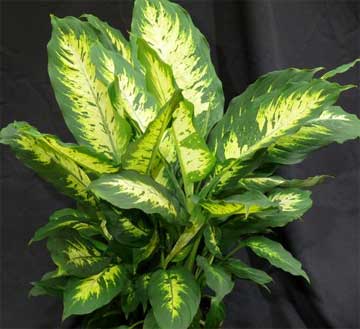
Dieffenbachia ‘Star Bright’ – New leaves have dark green margins on cream-white foliage with speckles dark green speckles. Long, narrow leaves, unlike most other Dieffenbachia varieties on the market.
Dieffenbachia ‘Sterling’ pp #14762P2 – Compact, well-branched plants with averaging 4-8 basal shoots per plant. New growth has very deep green leaves highlighted with dramatic white midrib extending from the leaf base to the leaf tip creating a herring-bone pattern.
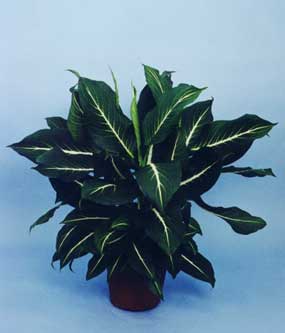
Dieffenbachia ‘Tiki’ pp #7298 (expired) – Deep green margins on the leaf edge with light green venation fading to dark with bright white spots. This sport or cultivar was discovered at Vanderlaan’s Nursery, Inc., Lake Worth, Fla., from a population of asexually propagated Dieffenbachia memoria Corsii plants. [source]
Dieffenbachia ‘Triumph’ – creamy white leaves with a green border and a pink cast at the petiole base. Grows to 22 inches tall.
Dieffenbachia ‘Tropic Marianne’ pp #8832 – characterized by a dense upright branched habit and new leaves are yellow-green oblong leaves bordered with green.
Dieffenbachia ‘Wilson’s Delight’ – large solid-green leaves with a white mid-vein.
Learn about dieffenbachia hybridization at the University of Florida.

What Are The Best Uses For The Dieffenbachia Plant?
The larger Dieffenbachia varieties make excellent floor plants. Make sure to place them in locations where traffic is low to prevent new leaves from being damaged.
Also, large plants can topple over if they get top-heavy or dry out when placed in areas where they may experience drafts.
Smaller varieties that reach 24” to 30” inches tall can also function as floor plants. Others can make great additions as single specimens in an attractive decorative pot on a desk or credenza.
Smaller Dieffenbachia varieties make good bathroom plants with the high humidity found in bathrooms.
Wrapping Up Caring For Dieffenbachia
For the best look, thriving Dieffenbachia plants should have a bushy shape with a compact frame, new growth, full, glossy leaves, and a healthy and succulent appearance.
Even with the “downside,” the Dieffenbachia is a wonderful addition for indoor use and brings a real tropical look to any interior.
The 56 Dieffenbachia Species are listed on The World Checklist of Selected Plant Families Maintained by the Royal Botanic Gardens, Kew. The species call Central and South America home.
- Dieffenbachia aglaonematifolia – Brazil, Paraguay; Corrientes + Misiones Provinces of Argentina
- Dieffenbachia antioquensis – Colombia
- Dieffenbachia aurantiaca – Costa Rica, Panama
- Dieffenbachia beachiana – Costa Rica, Panama
- Dieffenbachia bowmannii – Colombia, northwestern Brazil
- Dieffenbachia brittonii – Colombia
- Dieffenbachia burgeri – Costa Rica
- Dieffenbachia cannifolia – Colombia, Ecuador, Peru
- Dieffenbachia concinna – Costa Rica, Nicaragua
- Dieffenbachia copensis – Panama
- Dieffenbachia cordata – Peru
- Dieffenbachia costata Klotzsch – Colombia, Ecuador, Peru
- Dieffenbachia crebripistillata – Panama
- Dieffenbachia daguensis – Colombia, Ecuador
- Dieffenbachia davidsei – Costa Rica
- Dieffenbachia duidae – Venezuela, Guyana
- Dieffenbachia elegans – Bolivia, northwestern Brazil, the Guianas
- Dieffenbachia enderi – Colombia
- Dieffenbachia fortunensis – Panama
- Dieffenbachia fosteri – Panama
- Dieffenbachia fournieri – Colombia
- Dieffenbachia galdamesiae – Panama
- Dieffenbachia gracilis – Peru, northwestern Brazil
- Dieffenbachia grayumiana – Costa Rica, Panama, Colombia
- Dieffenbachia hammelii – Costa Rica, Nicaragua
- Dieffenbachia herthae – Ecuador
- Dieffenbachia horichii – Costa Rica
- Dieffenbachia humilis – Bolivia, Peru, Ecuador, northwestern Brazil, the Guianas
- Dieffenbachia imperialis – Peru
- Dieffenbachia isthmia – Panama
- Dieffenbachia killipii – Panama
- Dieffenbachia lancifolia – Colombia
- Dieffenbachia leopoldii – Colombia
- Dieffenbachia longispatha – Honduras, Nicaragua, Costa Rica, Panama, Colombia, Venezuela
- Dieffenbachia lutheri – Panama
- Dieffenbachia macrophylla – Peru
- Dieffenbachia meleagris – Ecuador
- Dieffenbachia nitidipetiolata – Panama
- Dieffenbachia obliqua – Peru
- Dieffenbachia obscurinervia – Panama
- Dieffenbachia oerstedii – southern Mexico (Veracruz, Tabasco, Campeche, Oaxaca, Chiapas), Central America (all 7 countries), Colombia
- Dieffenbachia olbia – Peru
- Dieffenbachia paludicola – northwestern Brazil, the Guianas, Venezuela
- Dieffenbachia panamensis – Panama
- Dieffenbachia parlatorei – Colombia, Venezuela
- Dieffenbachia parvifolia – northwestern Brazil, Bolivia, Ecuador, Peru, Venezuela
- Dieffenbachia pittieri – Panama
- Dieffenbachia seguine – West Indies, south to Brazil and Bolivia
- Dieffenbachia shuttleworthiana – Colombia
- Dieffenbachia standleyi – Honduras
- Dieffenbachia tonduzii – Nicaragua, Costa Rica, Panama, Colombia, Ecuador
- Dieffenbachia weberbaueri – Peru
- Dieffenbachia weirii – Colombia
- Dieffenbachia wendlandii – southern Mexico (Querétaro, Veracruz, Oaxaca, Chiapas) south to Panama
- Dieffenbachia williamsii – Bolivia
- Dieffenbachia wurdackii – Peru

